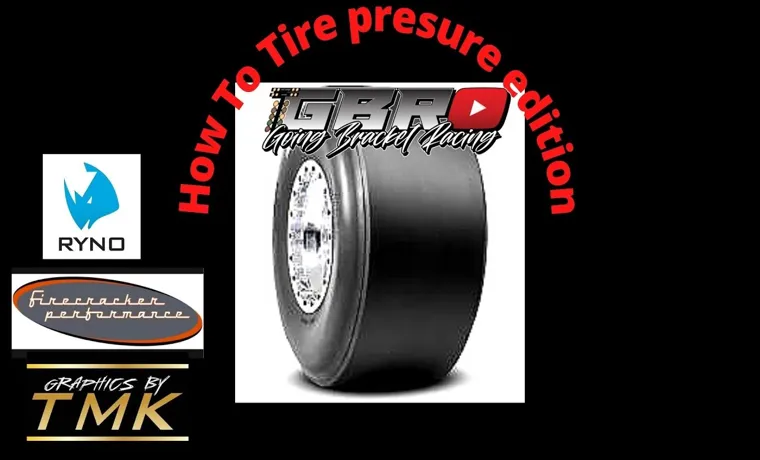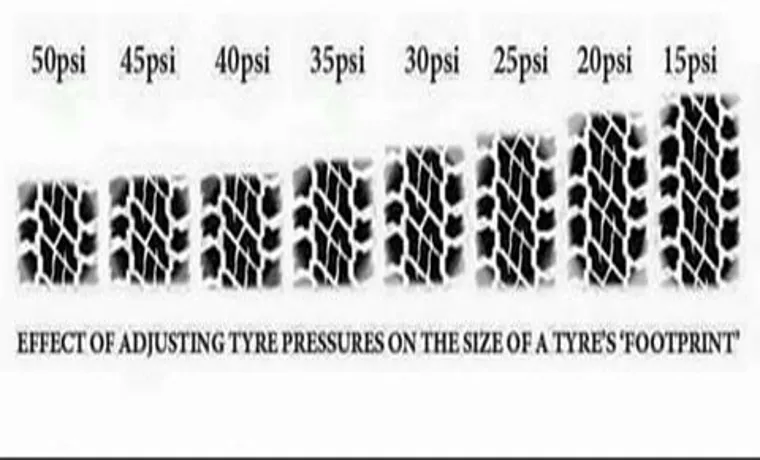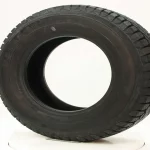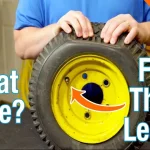If you’ve recently upgraded your vehicle with larger tires, then calculating the right tire pressure is essential to ensure a smooth and safe ride. Bigger tires require different pressure levels compared to the standard ones that came with your car. Not to mention, incorrect tire pressure can cause premature wear and tear, affect fuel efficiency, and even cause safety hazards.
So, how do you calculate tire pressure for bigger tires? Think of it like inflating a balloon. The bigger the balloon, the more air it needs to keep its structure intact. Similarly, bigger tires need more air pressure to support their weight and maintain their shape.
In this blog, we’ll explore some tips and tricks to help you calculate the right tire pressure for bigger tires and keep your vehicle in optimum condition.
Table of Contents
Understanding the Basics of Tire Pressure
Calculating the proper tire pressure for bigger tires can be a bit of a challenge. One important factor to consider is the weight of the vehicle, which affects the air pressure required in the tires. To determine the correct pressure for your larger tires, you’ll need to take into account the maximum load that your vehicle can carry, as well as the recommended pressure level provided by the tire manufacturer.
In general, the more weight your vehicle is carrying, the higher the air pressure needed in the tires. It’s also important to regularly check the pressure of your tires, as changes in temperature can affect the air pressure inside them. By keeping an eye on your tire pressure and making adjustments as needed, you’ll help ensure that your vehicle handles properly and remains safe on the road.
Why Correct Tire Pressure is Important
Tire pressure is one of those things that often gets overlooked, but it’s actually really important for a number of reasons. Essentially, the right tire pressure means that your car is safer, more efficient, and more comfortable to drive. So, what is tire pressure exactly? It’s the measure of how much air is inside your tires, and it’s usually expressed in pounds per square inch (PSI).
The optimal tire pressure for your car can usually be found in the owner’s manual, and it’s important to stick to this as closely as possible. If your tire pressure is too low, your car will use more fuel, your tires will wear out faster, and you’ll have less control over your car. If it’s too high, you’ll get a bumpier ride and risk a blowout.
So, take the time to check your tire pressure regularly, and make sure you keep them at the right level for a safer and more efficient driving experience.

Factors Affecting Tire Pressure
Tire pressure is an important factor that affects the performance of your vehicle and your safety on the road. Understanding the basics of tire pressure is essential for every driver. Simply put, tire pressure refers to the amount of air that is in your tires.
The ideal tire pressure is determined by the manufacturer of your vehicle and can be found in the owner’s manual or on a sticker on the driver’s side door jamb. It’s important to maintain the proper tire pressure to ensure the best handling, fuel efficiency, and tire life. Overinflating or underinflating your tires can lead to uneven wear and tear, decreased fuel economy, and even a potential blowout.
Additionally, various factors can affect tire pressure, such as temperature, altitude, and the weight of your vehicle. That’s why it’s essential to routinely check your tire pressure and adjust it as needed to ensure a safer and smoother ride.
Determining the Correct Tire Pressure for Your Vehicle
When it comes to calculating the right tire pressure for bigger tires, there are a few things to keep in mind. First and foremost, it’s important to consult your vehicle’s owner manual to determine the recommended tire pressure. This can vary depending on the type of tire and the weight of your vehicle.
However, if you’ve upgraded to bigger tires, you’ll likely need to adjust your tire pressure accordingly. Generally speaking, you’ll want to decrease your tire pressure slightly to ensure a smoother ride and better traction. As a general rule of thumb, you’ll want to decrease your tire pressure by about 5 PSI for every inch of added tire diameter.
For example, if you’ve gone from a 31″ tire to a 33″ tire, you’ll want to decrease your tire pressure by around 10 PSI. It’s worth noting that different types of tires may require different pressure adjustments, so it’s always a good idea to check with a professional if you’re unsure. Ultimately, finding the right tire pressure for your bigger tires is all about finding a balance between comfort, performance, and safety.
Finding the Recommended Tire Pressure
When it comes to maintaining your vehicle’s health and safety, tire pressure is a crucial factor to consider. But how do you know the recommended tire pressure for your specific vehicle? The answer lies in your car’s owner’s manual or on a sticker located on the driver’s side door jamb. These resources provide the recommended tire pressure in pounds per square inch (PSI) for both the front and rear tires.
It’s important to keep in mind that proper tire inflation varies depending on whether you have a passenger car, truck, or SUV, as well as factors such as the load capacity and tire size. Maintaining the correct tire pressure can improve fuel efficiency, extend tread life, and enhance overall driving safety. Don’t forget to check your tire pressure at least once a month with a tire pressure gauge and adjust accordingly.
Remember: keeping your tires properly inflated is an easy and effective way to take care of your vehicle and ensure a smooth ride.
Adjusting Tire Pressure for Bigger Tires
Adjusting tire pressure is a crucial task you should perform when you have bigger tires than the manufacturer recommended. Tires come in different sizes and shapes, and their pressure is determined by their size, weight, and usage. When adjusting tire pressure, you should consider the weight of your vehicle, the load capacity, and the terrain you will be driving on.
The correct tire pressure determines the safety and performance of your vehicle. Higher tire pressure reduces rolling resistance, which improves fuel efficiency and handling, but reduces braking power and ride comfort. Lower tire pressure, on the other hand, increases the tire’s contact with the road, which improves traction and ride comfort but reduces fuel efficiency and handling.
You should consult the tire manufacturer’s recommended pressure range and adjust the tire pressure accordingly for optimal performance and safety.
Calculating Tire Pressure Using a Tire Load Index Chart
When it comes to car maintenance, tire pressure can sometimes be overlooked. However, it’s important to ensure that your vehicle has the correct tire pressure to ensure your safety and prolong the life of your tires. One way to determine the correct tire pressure is by using a tire load index chart.
This chart takes into account the weight of your vehicle and how many tires are supporting that weight. With this information, you can find the recommended tire pressure for your vehicle. It’s important to note that the recommended tire pressure may differ for the front and rear tires.
Ensuring that your tires are properly inflated can also improve your fuel efficiency and reduce the risk of a blowout. So, the next time you’re checking your tire pressure, be sure to consult a tire load index chart to determine the correct amount of air your tires need to keep you rolling safely down the road.
Monitoring Tire Pressure
If you have recently installed bigger tires on your vehicle, it is essential to monitor the tire pressure to ensure optimal performance and efficiency. Calculating tire pressure for bigger tires can be a bit tricky, but it can be done with ease. Firstly, check your vehicle’s manual to determine the recommended tire pressure.
Then, use a tire pressure gauge to measure the current pressure. Next, calculate the difference between the recommended pressure and the current pressure. Finally, adjust the pressure accordingly using the appropriate air pressure equipment.
By maintaining the correct tire pressure, you can extend the lifespan of your tires, improve handling, and reduce the likelihood of a blowout. Don’t neglect this critical component of a car’s maintenance, and prioritize monitoring tire pressure regularly.
How Often to Check Tire Pressure
Monitoring tire pressure is an essential task for maintaining a safe and smooth driving experience. Irregular tire pressure may lead to unstable handling, poor fuel efficiency, and, worst of all, a tire blowout. Thus, knowing when to check your tire pressure is crucial.
Experts recommend checking it at least once a month, but other factors may also influence the frequency of monitoring your tire pressure. If you frequently drive on rough terrain or long distances, you may want to check your tire pressure more regularly. Similarly, sudden changes in temperature can affect your tire pressure, so it’s essential to keep an eye on it during colder months.
Another good practice is to check it before long road trips to ensure a comfortable journey. Regular monitoring will guarantee that your tires remain in optimal condition, saving money by avoiding unnecessary repairs in the future. Always remember that checking your tire pressure regularly is a small yet crucial step in maintaining road safety and keeping your vehicle in top condition.
Signs of Incorrect Tire Pressure
Monitoring your tire pressure is an essential aspect of maintaining your vehicle’s safety and performance. Low tire pressure can cause various issues, such as reduced handling, poor fuel efficiency, and increased wear and tear on your tires. Signs of incorrect tire pressure include a visible bulge on the tire’s sidewall, uneven tread wear, and a vibration in the steering wheel.
Regularly monitoring your tire pressure is crucial to preventing these issues. You can check your tire pressure with a gauge or by visually inspecting your tires. It’s best to check your tire pressure when the tires are cold, as heat can cause air pressure to increase and give inaccurate readings.
Maintaining the correct tire pressure is essential for safe and efficient driving. It can also prolong the life of your tires, helping you save money in the long run. Remember to monitor your tire pressure regularly, especially before a long trip, and adjust it as needed to keep your vehicle performing at its best.
Conclusion
In summary, calculating tire pressure for bigger tires requires a bit of math and an understanding of your vehicle’s weight and tire size. But fear not, with a little bit of effort, you can avoid the headache of underinflated tires and enjoy a smoother, safer ride. So grab your calculator and get ready to crunch some numbers – your tires will thank you!”
FAQs
What is the recommended tire pressure for bigger tires?
The recommended tire pressure for bigger tires can vary depending on the size and weight of your vehicle. It’s best to consult the tire manufacturer or a professional mechanic for specific recommendations.
Can I use the same tire pressure for bigger tires as I did for my previous tires?
No, the tire pressure for bigger tires may need to be adjusted to ensure proper performance and safety. Refer to the tire manufacturer’s guidelines or consult a professional mechanic.
How does the size of the tire affect the recommended tire pressure?
The size of the tire can affect the recommended tire pressure due to the weight and load-carrying capacity of the vehicle. Larger tires may require higher pressure to support the weight of the vehicle.
What are the risks of driving with incorrect tire pressure for bigger tires?
Driving with incorrect tire pressure can lead to increased wear and tear on the tires, reduced fuel efficiency, and decreased handling and safety performance.
How often should I check the tire pressure for bigger tires?
It’s recommended to check the tire pressure for bigger tires at least once a month, as well as before long trips and after any significant changes in weather or driving conditions.
Can I use the standard tire pressure gauge for bigger tires?
Yes, you can use a standard tire pressure gauge to check the pressure of bigger tires. However, you may need to use an air compressor with higher capacity to inflate the tires properly.
How can I tell if my tire pressure is too high or too low for my bigger tires?
You can check the recommended tire pressure for your bigger tires in the owner’s manual or on the tire itself. Use a tire pressure gauge to measure the pressure and compare it to the recommended range. If the pressure is too high or too low, adjust it accordingly.



